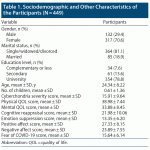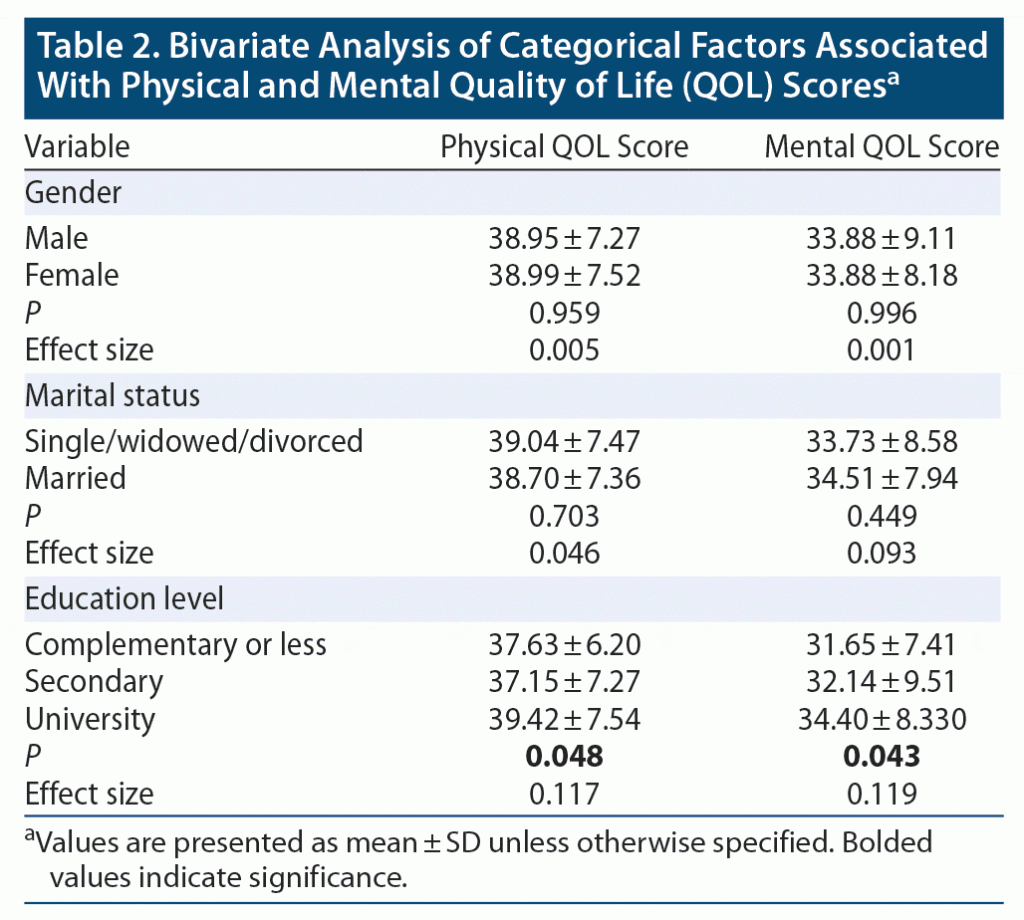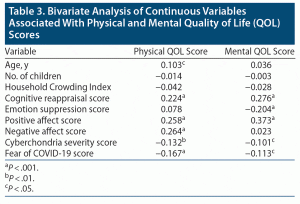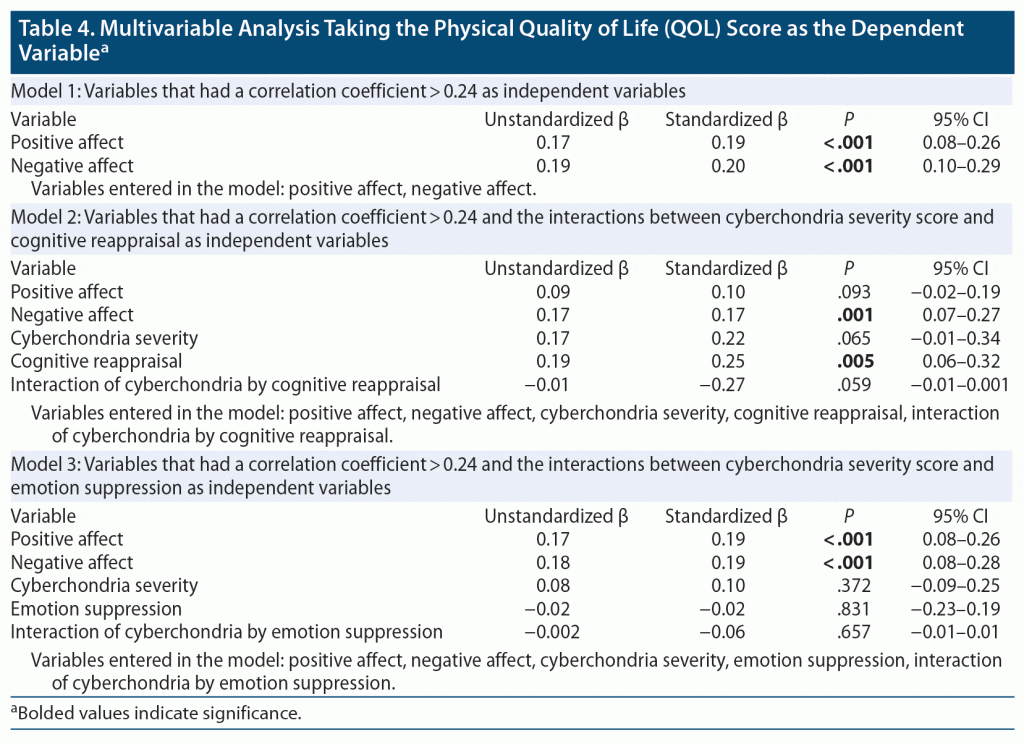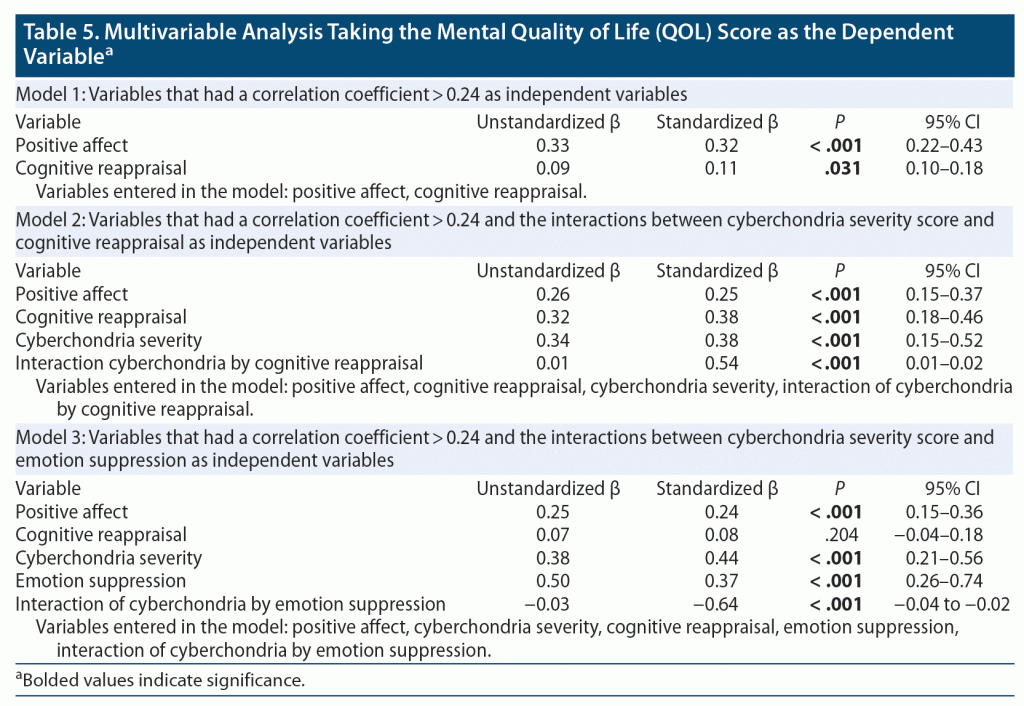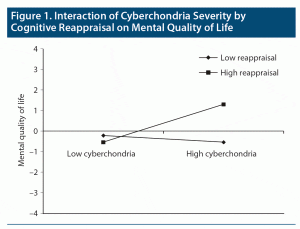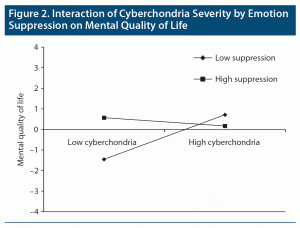ABSTRACT
Objective: To examine the correlation between cyberchondria and quality of life (QOL) among Lebanese adults during the COVID-19 pandemic, taking into consideration the moderating role of emotions (emotion regulation and positive and negative affect). The following questions were examined: (1) Do greater cyberchondria severity and fear of COVID-19 lead to poorer quality of physical and mental health? (2) How is positive and negative affect related to physical and mental QOL? and (3) How do emotion suppression and cognitive reappraisal correlate with physical and mental QOL, particularly in those with higher cyberchondria?
Methods: This cross-sectional study was performed between December 2020 and January 2021 during the COVID-19 pandemic. The study enrolled 449 participants who completed an online questionnaire. The questionnaire included sociodemographic questions and the following scales: Cyberchondria Severity Scale, Quality of Life Short Form‐12 Health Survey, Fear of COVID-19 Scale, Emotion Regulation Questionnaire, and Positive and Negative Affect Schedule.
Results: The results showed that more positive affect (B = 0.17) and negative affect (B = 0.19) were positively correlated with higher physical QOL scores. More positive affect (B = 0.33) and cognitive reappraisal (B = 0.09) were significantly associated with higher mental QOL scores. The interactions between cyberchondria severity by cognitive reappraisal and cyberchondria severity by emotion suppression were significantly associated with mental QOL (P < .001 for both). In people with high cyberchondria severity, having high cognitive reappraisal was strongly correlated with better mental QOL. In people with high cyberchondria severity, having low emotion suppression was significantly correlated with better mental QOL (P < .001).
Conclusions: Exposure to copious amounts of information, whether from verifiable sources or not, can instigate anxious symptoms in individuals who lack adaptive emotion regulation ability. Further studies are needed to identify factors related to health crisis response and their moderators, which can be useful to better understand the incidence and development of anxiety and allow health professionals to develop and implement preventive and therapeutic interventions.
Prim Care Companion CNS Disord 2023;25(2):22m03252
To cite: Tarabay C, Bitar Z, Akel M, et al. Cyberchondria severity and quality of life among Lebanese adults: the moderating effect of emotions. Prim Care Companion CNS Disord. 2023;25(2):22m03252.
To share: https://doi.org/10.4088/PCC.22m03252
© 2023 Physicians Postgraduate Press, Inc.
aSchool of Medicine and Medical Sciences, Holy Spirit University of Kaslik, Jounieh, Lebanon
bFaculty of Medicine, Paris-Saclay University, Le Kremlin-Bicêtre, France
cSchool of Pharmacy, Lebanese International University, Beirut, Lebanon
dResearch Department, Psychiatric Hospital of the Cross, Jal Eddib, Lebanon
eApplied Science Research Center, Applied Science Private University, Amman, Jordan
fSocial and Education Sciences Department, School of Arts and Sciences, Lebanese American University, Jbeil, Lebanon
‡Christina Tarabay and Zeinab Bitar are first coauthors. Souheil Hallit, Sahar Obeid, and Michel Soufia are last coauthors.
*Corresponding author: Souheil Hallit, PharmD, MSc, MPH, PhD, School of Medicine and Medical Sciences, Holy Spirit University of Kaslik, PO Box 446, Jounieh, Lebanon ([email protected]).
Cyberchondria can be defined as behavior marked by frequent online searching for medical and illness-related information linked to heightened levels of health anxiety.1,2 Given advancements in information and communication technologies, the internet has become the primary source of health-related information for many people.3,4 While a lot of health-related material is available online, some information may be misleading, as the provided diagnosis or treatments may be incorrect. In a study5 of more than 12,000 participants, almost half of the sample used the internet for self-diagnosis.
While the propagation of COVID-19–related news through media channels proved helpful in increasing awareness among the public and guiding measures undertaken by local authorities in response to the viral spread, it also had the unintentional consequence of overloading people with information about the threat posed by the disease as well as its health consequences.6 Scientific information about the virus was interspersed with troubling images and copious amounts of misinformation.7 In response, the World Health Organization (WHO) announced in February 20208 that 2 prevailing threats related to the COVID-19 outbreak are the pandemic and a massive “infodemic,” ie, the “overabundance of information—some accurate and some not—that makes it hard for people to find trustworthy sources and reliable guidance when they need it.” Research on current and previous health crises has shown that repeated media exposure can lead to augmented anxiety and stress response among community members, negatively affecting physical and mental health.9,10 Cyberchondria may be present in such situations.11
According to a recent study,12 perceived information overload and trust in information found online are related to increased incidence of COVID-19–related cyberchondria. Two frameworks exist to define cyberchondria. The first describes it as excessive or repetitive research via the internet of health-related information followed by a rise in distress and anxiety related to health.1,13 The second reflects a multidimensional, syndrome-like view of cyberchondria that includes components of anxiety and compulsiveness, including time-consuming and repetitive online health behavior, the associated distress and negative emotional states, and disruption of daily activities due to research and physician visits.14
During challenging circumstances such as pandemics, “fear” presents a natural response that keeps individuals away from danger and risky behaviors.15 When COVID-19 began to spread, research showed a sharp increase in fear of the virus.16 Fear can trigger safety behaviors such as hand washing and fear of contamination.17 Loss of loved ones, economic crisis, unemployment, and isolation due to lockdown also intensify fear of the virus.18 Additionally, being exposed to information about a forthcoming threat (such as the COVID-19 pandemic) has been found to be correlated with elevated levels of fear.19 During the pandemic, news bulletins and social media about new deaths and cases propagated fast, leading to increased fear.20 Previous studies concluded that fear and anxiety caused by the pandemic predicted cyberchondria.10,21
The emotion of fear reflects affective activation in response to a threatening stimulus within a limited period of time.22 Neurobiological activity in states of fear overlaps with activity that characterizes negative affectivity, the tendency toward anxiousness, depression, neuroticism, and general distress.23 Schachter and Singer24 defined emotion as a state of physiological arousal and of cognition appropriate to this state of arousal. Negative affect is emotional stress and unpleasant engagement consisting of a wide range of negative mood states, eg, anger, hate, disgust, guilt, worry, and anxiety.25 On the other hand, positive affect describes how passionate, energetic, and alert a person is. Low positive affect is associated with unhappiness and fatigue, whereas high positive affect is correlated to high energy, maximum focus, and joyful interactions.25 According to Fredrickson,26 positive emotions increase coping resources available to the individual and enhance creativity and flexibility in the long term. Many studies have found that people with positive emotional states may experience less cyberchondria, whereas individuals experiencing cyberchondria might have difficulty regulating negative emotions.1,27
Negative affectivity has been linked to trouble in emotion regulation in a variety of forms, including health anxiety.28,29 Emotion dysregulation involves issues related to cognitive reappraisal, cognitive avoidance, or expressive suppression. Both negative affectivity and emotion dysregulation have been found to contribute to the translation of body sensations or symptoms to illness, which in turn causes health anxiety in stressful circumstances.30 Cognitive reappraisal refers to the effort that occurs early in the emotion-generative process to replace the ignition of an emotion-eliciting stimulus to alter its emotional influence and is considered an adaptive emotion management strategy. Meanwhile, expressive suppression denotes the prevention of behavior that exhibits emotion and occurs later in the emotion-generative mechanism and is viewed as a maladaptive emotion regulation process.31 It is more challenging for those with higher levels of health anxiety to reappraise their health-related emotions when experiencing negative affect, thus they may resort to suppressing them.
Anxiety can have a significant impact on individuals, and has been shown to affect people’s quality of life (QOL).32,33 In the disciplines of health and medicine, QOL presents a key concept for study and practice.34 Many researchers have focused on patients’ QOL, and the use of QOL assessments has expanded.35 According to WHO, QOL is described as “an individual’s perception of their position in life in the context of the culture they live in and in relation to their goals, expectations, standards, and concerns.”36 Previous studies have shown that health anxiety and health-related internet use are correlated with higher depression and functional impairment.37–39 However, a small number of studies have investigated the impact of cyberchondria on everyday activities and functioning, QOL, and utilization of health care services.40 Mathes and colleagues40 found that people with cyberchondria may be functionally impaired but still satisfied with their life; no link between cyberchondria and QOL were identified in their study. Geng and colleagues found that negative emotions were negatively correlated with low QOL.41 Additionally, anxiety42 and depression43 were found to be associated with poor QOL. On the other hand, another study44 showed that individuals who live their life with positive emotions present better QOL and resilience when faced with challenges. Research has also revealed that people who experience and express positive emotions present not only better QOL45 but also duration of life (ie, longevity).46,47
In 2018, the World Economic Forum listed online misinformation as one of the top 10 threats to individuals.12 Research has highlighted that misinformation can lead to health anxiety,48 poor health outcomes,49 and impairment, resulting in an inability to evaluate the severity of ongoing problems.50 The present study mainly stems from the COVID-19 outbreak, which enhanced and heightened the possibility of these outcomes in a new way. The pandemic imposed many restrictions such as lockdown and social distancing rules, which pushed people toward increased use of the internet to engage with others.51 Despite the positive impacts of communication during stressful circumstances on mental health, the number of individuals with cyberchondria and psychological stress experienced in association with safety measures implemented during the pandemic is expected to rise significantly due to easy access to the Web and health-related information. Until now, despite established correlations between cyberchondria, fear, and negative and positive affect, there are limited studies on relevant psychological factors associated with cyberchondria in the context of the COVID-19 outbreak, particularly in Lebanon, which has experienced economic, social, and political crises. The objective of this study was to investigate the relationship between cyberchondria and QOL among Lebanese adults, taking into consideration the moderating role of emotions (emotion regulation and positive/negative affects). The following questions were examined: (1) Does greater cyberchondria severity and fear of COVID-19 lead to poorer quality of physical and mental health? (2) How is positive and negative affect related to physical and mental QOL? and (3) How does emotion suppression and cognitive reappraisal correlate with physical and mental QOL, particularly in those with higher cyberchondria?
METHODS
Study Design
This cross-sectional study was conducted between December 2020 and January 2021. During this period, the COVID-19 pandemic was still at its peak. Lockdown was implemented, and measures undertaken by the government were changing constantly based on the number of cases identified during a given period. The snowball technique was used to select the sample. Participants who consented to participate were chosen from the 5 governorates of Lebanon. Participants were provided information on the study topic as well as the questionnaire. Anonymity was guaranteed before they started answering questions. The inclusion criteria were Lebanese residents aged ≥ 18 years. The methodology used in the study was described previously.52
Minimal Sample Size Calculation
The smallest sample possible was 395, which was computed using the G-power software. A linear regression model was used with parameters as follows: an α error of 5%, a power of 80%, and 10 factors.
Questionnaire
The official language of Lebanon (ie, Arabic) was used to develop the questionnaire. It is the native language of the participants in the survey. The questionnaire consisted of 2 categories: sociodemographic category used to define the group or population that the participants belonged to and a scale-based category used to evaluate the criteria needed for the study.
Sociodemographic Data
The questions in this category were used to define the population that the participants belong to based on social and demographic factors. Among these factors, the participants had to state their age, level of education, income, marital status, number of children, and House Crowding Index data. The index is computed by dividing the number of persons living in the house by the total number of rooms in the house excluding the bathroom and the kitchen.53
Scale-Based Data
Various scales were used in the questionnaire to generalize our results and compare them with other studies. The scales used in the questionnaire are as follows.
Cyberchondria Severity Scale
The Cyberchondria Severity Scale includes 12 questions that were taken from the original scale comprised of 33 items.14,54 This scale allows the assessment of cyberchondria based on compulsion, stress, recurrence, and excessive use without the mistrust of medical professionals. A 5-point Likert scale is used, with higher scores reflecting higher cyberchondria. The Cronbach α for the scale in this study was 0.919.
Quality of Life Short Form‐12 Health Survey
The survey used was translated to Arabic and validated in Lebanon.55 This scale comprises 12 items. The scores range from 0 to 100 and are directly correlated to the higher physical/mental QOL. The Cronbach α for these 2 subscales was 0.746.
Fear of COVID-19 Scale
The Fear of COVID-19 Scale56 presents 1 score and is a unidimensional scale that reflects fear of the disease. Seven items are scored on a 5-point Likert scale, with higher scores indicating greater fear of COVID-19. The Cronbach α for the total scale in this study was 0.884.
Emotion Regulation Questionnaire
The Emotion Regulation Questionnaire was translated to Arabic and validated in Lebanon.57 The questionnaire is used to assess individuals’ tendency to regulate their emotions in 2 ways: (1) cognitive reappraisal and (2) expressive suppression. The instrument comprises 10 items rated on a 7-point Likert-type scale. Cognitive reappraisal is thinking in a different perspective about an event to change its meaning and alter one’s emotional experience. Expressive suppression refers to decreasing the outward expression of emotion. There are 6 items in the subscale for cognitive reappraisal and 4 items in the subscale for expressive suppression.58 The Cronbach α for cognitive reappraisal in this study was 0.922 and for expressive suppression was 0.844.
Positive and Negative Affect Schedule
The Positive and Negative Affect Schedule is used to measure mood or emotion. This instrument comprises 20 items, with 10 items measuring positive affect (eg, excited, inspired) and 10 items measuring negative affect (eg, upset, afraid). It is scored on a 5-point Likert scale, measuring the extent to which the affect has been experienced in a specified time frame.23 The Cronbach α for positive affect in this study was 0.912 and for negative affect was 0.880.
Translation Procedure
The non-validated scales were translated from English to Arabic by a clinical psychologist, and a professional medical writer made sure that the translation was correct. To further verify the correctness of the process, a backward translation was done by another psychologist who was unaware of the scales. The back-translated version of the questions was matched with the original to find any discrepancies and improve the translation process. A committee composed of a psychologist, psychiatrist, and pharmacist verified the process.
Statistical Analysis
The statistical analysis was conducted using SPSS version 25. The sample was normally distributed as verified by the skewness and kurtosis of the physical and mental QOL scores, which varied between −2 and +2.59 The Student t and analysis of variance tests were used to compare 2 and 3 or more means, respectively. Pearson correlation test was used to correlate 2 continuous variables. Linear regressions were conducted, taking the physical and mental QOL scores as dependent variables. Independent variables that showed a correlation coefficient > 0.24 were entered in the linear regressions to have more parsimonious models.60 Interactions between fear of COVID-19 by each emotion regulation subscale (reappraisal and suppression) were also tested in the final model. Significance was set at P < .05.
RESULTS
Sociodemographic and Other Characteristics of the Participants
Of 590 participants approached, 449 (76.10%) agreed to enroll in the study. The mean ± SD age of the participants was 24.34 ± 8.22 years, with 70.6% females. Table 1 includes more details about the sample.
Bivariate Analysis
Higher means for physical and mental QOL scores were found among participants that had a university level of education compared to the other levels (Table 2). Higher emotion reappraisal and positive and negative affect scores were strongly linked with higher physical QOL scores, whereas higher emotion reappraisal was significantly associated with higher mental QOL scores. Higher emotion suppression was associated with lower physician and mental QOL, while more fear of the COVID-19 and cyberchondria severity were strongly related with both lower physical and mental QOL (Table 3).
Multivariable Analysis
More positive affect (B = 0.17) and negative affect (B = 0.19) were strongly linked with higher physical QOL scores (Table 4, Model 1). The interactions of cyberchondria severity by cognitive reappraisal and cyberchondria severity by emotion suppression were not significantly correlated with physical QOL (Table 4, Models 2 and 3).
More positive affect (B = 0.33) and cognitive reappraisal (B = 0.09) were related with higher mental QOL scores (Table 5, Model 1). The interactions of cyberchondria severity by cognitive reappraisal and cyberchondria severity by emotion suppression were significantly associated with mental QOL (Table 5, Models 2 and 3). In people with high cyberchondria severity, having high cognitive reappraisal was strongly linked with better mental QOL (Figure 1). In people with high cyberchondria severity, having low emotion suppression was significantly correlated with better mental QOL (Figure 2).
DISCUSSION
Our results indicate an association between positive affect and physical and mental QOL. These results are in accordance with previous research. In 1989, Watson and Pennebaker61 found a strong association between positive affect and somatic health illnesses. Positive affect has been linked to lower cardiovascular disease severity and increased survival in patients with cardiovascular disease.62 Positive affect has also been found to be effective in increasing survival in patients with diabetes,63 which has been explained by the positive correlation between higher positive affect and glycemic control.64 In addition, positive affect may have beneficial effects on the immune system, as it induces higher levels of circulating white blood cells, reduces inflammation, and increases healing.65
Regarding the correlation between positive affect and mental QOL, Pressman and Cohen66 found that positive affect has a good effect on mental health and presents a buffer against stress. Some studies67,68 attribute this association to lower cortisol levels, which have been found among people with higher positive affect.
In our study, negative affect was associated with better physical QOL, which is in contradiction with previous studies. Research has shown that negative affect may lead to exaggerated physiologic arousal, as individuals with high negative affect are more focused on somatic sensations.61 The effect of negative affect on somatic sensations may lead to biological and physiologic mechanisms, increasing the likelihood of developing stress-related diseases69 and somatic complaints as well as seeking treatment and invasive diagnosis procedures.70 Also, Leger and colleagues71 found that negative affect may induce future physical health problems by extending activation of the physiologic stress response. These contradictory results may be due to the limitation of the scale used in our study to evaluate positive and negative affect, as the scale prompts individuals to rate their experience of emotional states either at the time of completing the survey or 2 weeks prior. This framework might have introduced multiple confounds, particularly as the country of Lebanon was experiencing economic, political, and social instability accompanied by day-to-day fluctuations in currency rates as well as shortages in the availability of basic necessities including fuel, food, and medication supplies at the time of the study.72 The mean age of the participants in this study was 24.34 years, which is a relatively young sample and outside the age range at greater risk of suffering from various physical ailments.
In our study, and in accordance with previous studies, it was found that positive reappraisal might improve the quality of emotional life73; it has been found to be significantly associated with better mental QOL.74 Positive reappraisal has been linked to better psychological health in various studies.31,75,76 Also, our findings revealed that in people with high cyberchondria severity, having high cognitive reappraisal was strongly correlated with better mental QOL. These results are in accordance with previous literature,77 in which researchers found that individuals with cyberchondria use the internet excessively with the hope of gaining relief and positive information. Emotion regulation and feeling positive have been shown to be buffers against negative emotional states; individuals who feel well experience less cyberchondria.1,27 Additionally, higher cognitive reappraisal has been found to be associated with lower disease conviction.30 Similarly, Jungmann and Witthöft77 found that more adaptive emotion regulation is associated with positive effects on mental health, particularly during the pandemic.
Furthermore, in individuals with high cyberchondria severity, having low emotion suppression was strongly linked to better mental QOL. Previous studies revealed that the suppression of emotion is linked with low mental health quality (predictor of depressive symptoms).78 Also, during the COVID-19 pandemic more maladaptive emotional regulation was found to be associated with greater virus anxiety.77 Additionally, more adaptive emotion regulation with a high level of information about the virus seems to have a positive effect (ie, less virus anxiety).77 These correlations are explained by 2 main moderators: the acceptance of what has happened or experienced and by comparing this experience with worse events. A negative association has been found between acceptance and putting anxiety into perspective.79,80
Practical Implications
According to our findings, cyberchondria should be considered an important public health issue. With the increased rate of digitalization, decreasing internet usage is not plausible; hence, controlling internet use, especially among those with cyberchondria, is a logical solution. Therefore, health professionals should develop targeted preventative strategies to decrease excessive medical information research on the internet and its harmful effects, specifically during a pandemic. These strategies include spreading information on ways to deal with the current pandemic, adopting optimism-boosting techniques, and publicizing the harmful consequences of excessive and recurrent internet searches for COVID-19–related material. Parents should be encouraged to spend more time with their children and decrease their daily screen time. In addition, people should be educated to distinguish between reliable and non-reliable information to prevent mental and physical problems.
Limitations and Strengths
This study has some limitations. This was a cross-sectional study, and, thus, the findings cannot establish a causal-effect relationship. Not all instruments employed in the study have been validated in Lebanon. Also, the findings may not be representative of the whole Lebanese population since 70.6% of the sample were female and the majority were single with a university education. Additionally, individuals may have overestimated or underestimated some questions, which may result in information bias. Other factors related to QOL were not assessed in the survey, predisposing to a confounding bias. Also, the respondents were not asked about prior COVID-19 infection, its severity if infected, or if anyone close to them had the virus. However, several noteworthy results were underlined in this study, and it is the first, to our knowledge, to evaluate the role of emotions in the relationship between cyberchondria and QOL in the Lebanese population. The findings of this study are a step toward identifying factors related with cyberchondria, such as emotion suppression and fear of COVID-19, and considering factors that help reduce health-related anxiety, such as cognitive reappraisal.
CONCLUSION
Our findings revealed a significant association between positive and negative affect and physical QOL. Cognitive reappraisal was associated with better mental QOL. Additionally, the association between higher cyberchondria severity and better mental QOL was found to be moderated by higher cognitive reappraisal or lower emotion suppression. Exposure to copious amounts of information, whether from verifiable sources or not, can instigate anxious symptoms in individuals who lack adaptive emotion regulation ability.
Considering the limitations of our research, we recommend that further studies should be done to better understand the correlations between cyberchondria, QOL, and related psychological factors. Furthermore, our study was conducted among the Lebanese population during the pandemic; therefore, more investigation should be conducted to conclude if the correlations we found can be generalized worldwide.
Submitted: January 28, 2022; accepted April 19, 2022.
Published online: April 27, 2023.
Relevant financial relationships: None.
Funding/support: None.
Acknowledgments: The authors thank the participants for agreeing to be part of this study.
Additional information: There is no public access to all data generated or analyzed during this study to preserve the privacy of the identities of the individuals. The dataset that supports the conclusions is available to the corresponding author upon request.
Clinical Points
- More positive affect and negative affect were correlated with higher physical quality of life (QOL).
- More positive affect and cognitive reappraisal were associated with higher mental QOL.
- In people with high cyberchondria severity, having high cognitive reappraisal was strongly correlated with better mental QOL.
- In people with high cyberchondria severity, having low emotion suppression was significantly correlated with better mental QOL.
- Exposure to copious amounts of information, whether from verifiable sources or not, can instigate anxious symptoms in individuals lacking adaptive emotion regulation ability.
References (80)

- Starcevic V, Berle D. Cyberchondria: towards a better understanding of excessive health-related Internet use. Expert Rev Neurother. 2013;13(2):205–213. PubMed CrossRef
- Vismara M, Caricasole V, Starcevic V, et al. Is cyberchondria a new transdiagnostic digital compulsive syndrome? a systematic review of the evidence. Compr Psychiatry. 2020;99:152167. PubMed CrossRef
- Kalckreuth S, Trefflich F, Rummel-Kluge C. Mental health related Internet use among psychiatric patients: a cross-sectional analysis. BMC Psychiatry. 2014;14(1):368. PubMed CrossRef
- Prescott J, Mackie L. “You sort of go down a rabbit hole...you’re just going to keep on searching”: a qualitative study of searching online for pregnancy-related information during pregnancy. J Med Internet Res. 2017;19(6):e194. PubMed CrossRef
- Maftei A, Holman AC. Cyberchondria during the coronavirus pandemic: the effects of neuroticism and optimism. Front Psychol. 2020;11:567345. PubMed CrossRef
- Kim S-W, Su K-P. Using psychoneuroimmunity against COVID-19. Brain Behav Immun. 2020;87:4–5. PubMed CrossRef
- Pulido CM, Villarejo-Carballido B, Redondo-Sama G, et al. COVID-19 infodemic: more retweets for science-based information on coronavirus than for false information. Int Sociol. 2020;35(4):377–392. CrossRef
- WHO. Coronavirus disease (COVID-19) [Internet]. WHO website. Accessed September 8, 2021. https://www.who.int/emergencies/diseases/novel-coronavirus-2019?adgroupsurvey={adgroupsurvey}&gclid=CjwKCAjwvuGJBhB1EiwACU1AieA05vjCzOy5BJqV-nUjtyP3ijeGg28h86NiD-eyYR9YppdQ63MpjxoCjIUQAvD_BwE
- Garfin DR, Silver RC, Holman EA. The novel coronavirus (COVID-2019) outbreak: amplification of public health consequences by media exposure. Health Psychol. 2020;39(5):355–357. PubMed CrossRef
- Seyed Hashemi SG, Hosseinnezhad S, Dini S, et al. The mediating effect of the cyberchondria and anxiety sensitivity in the association between problematic internet use, metacognition beliefs, and fear of COVID-19 among Iranian online population. Heliyon. 2020;6(10):e05135. PubMed CrossRef
- Varma R, Das S, Singh T. Cyberchondria amidst COVID-19 pandemic: challenges and management strategies. Front Psychiatry. 2021;12:618508. PubMed CrossRef
- Laato S, Islam AKMN, Islam MN, et al. What drives unverified information sharing and cyberchondria during the COVID-19 pandemic? Eur J Inf Syst. 2020;29(3):288–305. CrossRef
- Starcevic V. Cyberchondria: challenges of problematic online searches for health-related information. Psychother Psychosom. 2017;86(3):129–133. PubMed CrossRef
- McElroy E, Shevlin M. The development and initial validation of the cyberchondria severity scale (CSS). J Anxiety Disord. 2014;28(2):259–265. PubMed CrossRef
- Harper CA, Satchell LP, Fido D, et al. Functional Fear Predicts Public Health Compliance in the COVID-19 Pandemic. Int J Ment Health Addiction [Internet]. Springer website. 2020. Accessed September 19, 2021. https://link.springer.com/10.1007/s11469-020-00281-5
- Asmundson GJG, Taylor S. Coronaphobia: fear and the 2019-nCoV outbreak. J Anxiety Disord. 2020;70:102196. PubMed CrossRef
- Engelhard IM, van Uijen SL, van Seters N, et al. The effects of safety behavior directed towards a safety cue on perceptions of threat. Behav Ther. 2015;46(5):604–610. PubMed CrossRef
- Bitar Z, Haddad C, Obeid S, et al. Treatment satisfaction and its association with anxiety, depression and fear of COVID-19 among Lebanese inpatients with schizophrenia. Pharm Pract (Granada). 2021;19(3):2364. PubMed CrossRef
- Mertens G, Boddez Y, Sevenster D, et al. A review on the effects of verbal instructions in human fear conditioning: Empirical findings, theoretical considerations, and future directions. Biol Psychol. 2018;137:49–64. PubMed CrossRef
- Mertens G, Gerritsen L, Duijndam S, et al. Fear of the coronavirus (COVID-19): predictors in an online study conducted in March 2020. J Anxiety Disord. 2020;74:102258. PubMed CrossRef
- Wu X, Nazari N, Griffiths MD. Using fear and anxiety related to COVID-19 to predict cyberchondria: cross-sectional survey study. J Med Internet Res. 2021;23(6):e26285. PubMed CrossRef
- Vizueta N, Patrick CJ, Jiang Y, et al. Dispositional fear, negative affectivity, and neuroimaging response to visually suppressed emotional faces. Neuroimage. 2012;59(1):761–771. PubMed CrossRef
- Watson D, Clark LA, Tellegen A. Development and validation of brief measures of positive and negative affect: the PANAS scales. J Pers Soc Psychol. 1988;54(6):1063–1070. PubMed CrossRef
- Schachter S, Singer JE. Cognitive, social, and physiological determinants of emotional state. Psychol Rev. 1962;69(5):379–399. PubMed CrossRef
- P AS, Mariette TM, Majid SA. Positive and negative affect on quality of life: a review. IHRJ. 2017;1(5):7–9. CrossRef
- Fredrickson BL. The role of positive emotions in positive psychology: the broaden-and-build theory of positive emotions. Am Psychol. 2001;56(3):218–226. PubMed CrossRef
- Brown RJ, Skelly N, Chew-Graham CA. Online health research and health anxiety: a systematic review and conceptual integration. Clin Psychol Sci Pract. 2020;27(2)e12299. CrossRef
- Bakhshaie J, Rogers AH, Kauffman BY, et al. Emotion dysregulation as an explanatory factor in the relation between negative affectivity and non-medical use of opioid in a diverse young adult sample. Addict Behav. 2019;95:103–109. PubMed CrossRef
- El Archi S, Brunault P, De Luca A, et al. Do emotion dysregulation, alexithymia and personality dimensions explain the association between attention-deficit/hyperactivity disorder and binge eating among bariatric surgery candidates? Front Psychol. 2021;12:745857. PubMed CrossRef
- Fergus TA, Valentiner DP. Disease phobia and disease conviction are separate dimensions underlying hypochondriasis. J Behav Ther Exp Psychiatry. 2010;41(4):438–444. PubMed CrossRef
- John OP, Gross JJ. Healthy and unhealthy emotion regulation: personality processes, individual differences, and life span development. J Pers. 2004;72(6):1301–1333. PubMed CrossRef
- Jafari N, Farajzadegan Z, Loghmani A, et al. Spiritual well-being and quality of life of Iranian adults with type 2 diabetes. Evid Based Complement Alternat Med. 2014;2014:619028. PubMed CrossRef
- Mok MMY, Liu CKM, Lam MF, et al. A longitudinal study on the prevalence and risk factors for depression and anxiety, quality of life, and clinical outcomes in incident peritoneal dialysis patients. Perit Dial Int. 2019;39(1):74–82. PubMed CrossRef
- Staquet M, Berzon R, Osoba D, et al. Guidelines for reporting results of quality of life assessments in clinical trials. Qual Life Res. 1996;5(5):496–502. PubMed CrossRef
- Fayers PM, Machin D. Quality of Life: The Assessment, Analysis and Interpretation of Patient-Reported Outcomes. 2. Chichester: Wiley; 2007:544.
- The World Health Organization Quality of Life assessment (WHOQOL): position paper from the World Health Organization. Soc Sci Med. 1995;41(10):1403–1409. PubMed CrossRef
- Bessière K, Pressman S, Kiesler S, et al. Effects of internet use on health and depression: a longitudinal study. J Med Internet Res. 2010;12(1):e6. PubMed CrossRef
- Doherty-Torstrick ER, Walton KE, Fallon BA. Cyberchondria: parsing health anxiety from online behavior. Psychosomatics. 2016;57(4):390–400. PubMed CrossRef
- White RW, Horvitz E. Experiences with web search on medical concerns and self diagnosis. AMIA Annu Symp Proc. 2009;2009:696–700. PubMed
- Mathes BM, Norr AM, Allan NP, et al. Cyberchondria: overlap with health anxiety and unique relations with impairment, quality of life, and service utilization. Psychiatry Res. 2018;261:204–211. PubMed CrossRef
- Geng Y, Gu J, Zhu X, et al. Negative emotions and quality of life among adolescents: a moderated mediation model. Int J Clin Health Psychol. 2020;20(2):118–125. PubMed CrossRef
- Dryman MT, Gardner S, Weeks JW, et al. Social anxiety disorder and quality of life: how fears of negative and positive evaluation relate to specific domains of life satisfaction. J Anxiety Disord. 2016;38:1–8. PubMed CrossRef
- Arraras JI, Ibañez B, Pereda N, et al. The association of clinical insight and depression with quality of life in schizophrenia. Psychiatry Res. 2019;279:350–352. PubMed CrossRef
- Cohn MA, Fredrickson BL, Brown SL, et al. Happiness unpacked: positive emotions increase life satisfaction by building resilience. Emotion. 2009;9(3):361–368. PubMed CrossRef
- Harker L, Keltner D. Expressions of positive emotion in women’s college yearbook pictures and their relationship to personality and life outcomes across adulthood. J Pers Soc Psychol. 2001;80(1):112–124. PubMed CrossRef
- Danner DD, Snowdon DA, Friesen WV. Positive emotions in early life and longevity: findings from the nun study. J Pers Soc Psychol. 2001;80(5):804–813. PubMed CrossRef
- Moskowitz JT. Positive affect predicts lower risk of AIDS mortality. Psychosom Med. 2003;65(4):620–626. PubMed CrossRef
- Lewis T. Seeking health information on the internet: lifestyle choice or bad attack of cyberchondria? Media Cult Soc. 2006;28(4):521–539. CrossRef
- Allcott H, Gentzkow M. Social media and fake news in the 2016 election. J Econ Perspect. 2017;31(2):211–236. CrossRef
- Kata A. A postmodern Pandora’s box: anti-vaccination misinformation on the Internet. Vaccine. 2010;28(7):1709–1716. PubMed CrossRef
- Bitar Z, Hallit S, Khansa W, et al. Phubbing and temperaments among young Lebanese adults: the mediating effect of self-esteem and emotional intelligence. BMC Psychol. 2021;9(1):87. PubMed CrossRef
- Rahme C, Akel M, Obeid S, et al. Cyberchondria severity and quality of life among Lebanese adults: the mediating role of fear of COVID-19, depression, anxiety, stress and obsessive-compulsive behavior-a structural equation model approach. BMC Psychol. 2021;9(1):169. PubMed CrossRef
- Melki IS, Beydoun HA, Khogali M, et al; National Collaborative Perinatal Neonatal Network (NCPNN). Household crowding index: a correlate of socioeconomic status and inter-pregnancy spacing in an urban setting. J Epidemiol Community Health. 2004;58(6):476–480. PubMed CrossRef
- Fergus TA. The Cyberchondria Severity Scale (CSS): an examination of structure and relations with health anxiety in a community sample. J Anxiety Disord. 2014;28(6):504–510. PubMed CrossRef
- Haddad C, Sacre H, Obeid S, et al. Validation of the Arabic version of the “12-item short-form health survey” (SF-12) in a sample of Lebanese adults. Arch Public Health. 2021;79(1):56. PubMed CrossRef
- Ahorsu DK, Lin C-Y, Imani V, et al. The Fear of COVID-19 Scale: Development and Initial Validation. Int J Ment Health Addiction [Internet]. Springer website. Accessed September 8, 2021. https://link.springer.com/10.1007/s11469-020-00270-8
- Kahwagi RM, Zeidan RK, Haddad C, et al. Emotion regulation among Lebanese adults: validation of the Emotion Regulation Questionnaire and association with attachment styles. Perspect Psychiatr Care. 2021;57(2):809–820. PubMed CrossRef
- Gross JJ, John OP. Individual differences in two emotion regulation processes: implications for affect, relationships, and well-being. J Pers Soc Psychol. 2003;85(2):348–362. PubMed CrossRef
- George D. SPSS for Windows Step by Step : A Simple Guide and Reference, 17.0 Update. Boston: Allyn & Bacon; 2010.
- Vandekerckhove J, Matzke D, Wagenmakers E-J. In: Busemeyer JR, Wang Z, Townsend JT, et al, eds. Model Comparison and the Principle of Parsimony. Vol. 1. Oxford University Press; 2015. [Internet]. Accessed April 15, 2021. http://oxfordhandbooks.com/view/10.1093/oxfordhb/9780199957996.001.0001/oxfordhb-9780199957996-e-14
- Watson D, Pennebaker JW. Health complaints, stress, and distress: exploring the central role of negative affectivity. Psychol Rev. 1989;96(2):234–254. PubMed CrossRef
- DuBois CM, Lopez OV, Beale EE, et al. Relationships between positive psychological constructs and health outcomes in patients with cardiovascular disease: a systematic review. Int J Cardiol. 2015;195:265–280. PubMed CrossRef
- Moskowitz JT, Epel ES, Acree M. Positive affect uniquely predicts lower risk of mortality in people with diabetes. Health Psychol. 2008;27(suppl):S73–S82. PubMed CrossRef
- Nefs G, Pouwer F, Denollet J, et al. Suboptimal glycemic control in type 2 diabetes: a key role for anhedonia? J Psychiatr Res. 2012;46(4):549–554. PubMed CrossRef
- Marsland AL, Pressman S, Cohen S. Positive affect and immune function. Psychoneuroimmunology. 2007;2:761–779. CrossRef
- Pressman SD, Cohen S. Does positive affect influence health? Psychol Bull. 2005;131(6):925–971. PubMed CrossRef
- Hoppmann CA, Klumb PL. Daily goal pursuits predict cortisol secretion and mood states in employed parents with preschool children. Psychosom Med. 2006;68(6):887–894. PubMed CrossRef
- Jacobs N, Myin-Germeys I, Derom C, et al. A momentary assessment study of the relationship between affective and adrenocortical stress responses in daily life. Biol Psychol. 2007;74(1):60–66. PubMed CrossRef
- Suls J, Bunde J. Anger, anxiety, and depression as risk factors for cardiovascular disease: the problems and implications of overlapping affective dispositions. Psychol Bull. 2005;131(2):260–300. PubMed CrossRef
- Friedman HS. Long-term relations of personality and health: dynamisms, mechanisms, tropisms. J Pers. 2000;68(6):1089–1107. PubMed CrossRef
- Leger KA, Charles ST, Almeida DM. Let it go: lingering negative affect in response to daily stressors is associated with physical health years later. Psychol Sci. 2018;29(8):1283–1290. PubMed CrossRef
- Joelle M. Abi-Rached, Ishac DIwan. The Socioeconomic Impact of COVID-19 on Lebanon: A Crisis Within Crises : EuroMeSCo – Euro-Mediterranean Research, Dialogue, Advocacy [Internet]. Euromesco.net website. Accessed September 17, 2021. https://www.euromesco.net/publication/the-socioeconomic-impact-of-covid-19-on-lebanon-a-crisis-within-crises/
- Shiota MN, Levenson RW. Effects of aging on experimentally instructed detached reappraisal, positive reappraisal, and emotional behavior suppression. Psychol Aging. 2009;24(4):890–900. PubMed CrossRef
- Aldao A, Nolen-Hoeksema S, Schweizer S. Emotion-regulation strategies across psychopathology: a meta-analytic review. Clin Psychol Rev. 2010;30(2):217–237. PubMed CrossRef
- Garnefski N, Kraaij V. Relationships between cognitive emotion regulation strategies and depressive symptoms: a comparative study of five specific samples. Pers Individ Dif. 2006;40(8):1659–1669. CrossRef
- Kraaij V, Pruymboom E, Garnefski N. Cognitive coping and depressive symptoms in the elderly: a longitudinal study. Aging Ment Health. 2002;6(3):275–281. PubMed CrossRef
- Jungmann SM, Witthöft M. Health anxiety, cyberchondria, and coping in the current COVID-19 pandemic: which factors are related to coronavirus anxiety? J Anxiety Disord. 2020;73:102239. PubMed CrossRef78. Khalaila R, Cohen M. Emotional suppression, caregiving burden, mastery, coping strategies and mental health in spousal caregivers. Aging Ment Health. 2016;20(9):908–917. PubMed CrossRef
- Khalaila R, Cohen M. Emotional suppression, caregiving burden, mastery, coping strategies and mental health in spousal caregivers. Aging Ment Health. 2016;20(9):908–917. PubMed CrossRef
- Garnefski N, Legerstee J, Kraaij VV, et al. Cognitive coping strategies and symptoms of depression and anxiety: a comparison between adolescents and adults. J Adolesc. 2002;25(6):603–611. PubMed CrossRef
- Martin RC, Dahlen ER. Cognitive emotion regulation in the prediction of depression, anxiety, stress, and anger. Pers Individ Dif. 2005;39(7):1249–1260. CrossRef
Please sign in or purchase this PDF for $40.
